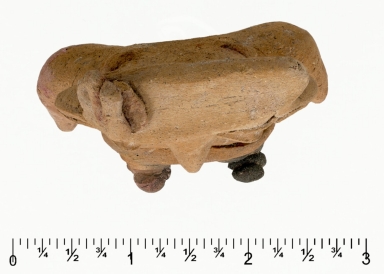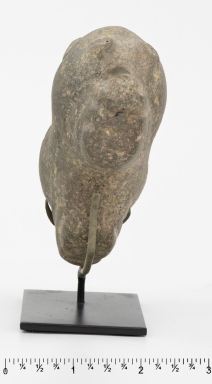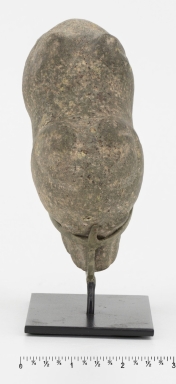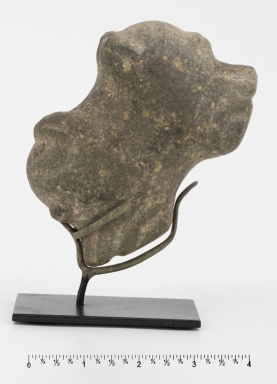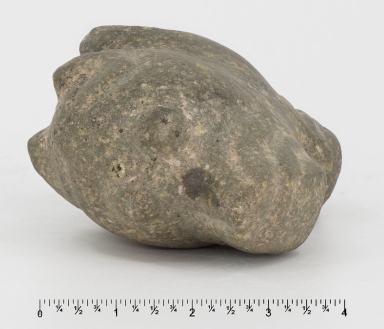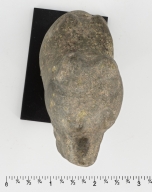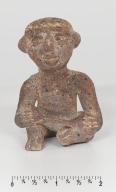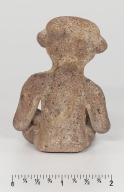|
REFINE
Browse All : Artifact from between 250 B.C. and 200 A.D.
1-18 of 18
Title
Standing male figure : ballplayer.
Description
His headdress, ear spools, and pendant necklace point to his elite status. The hip girdle and knee pads suggest his profession: a ballplayer. The buttons on his feet indicate the Chupicuaro culture from Guanajuato.
Subject
[Ceramic sculpture--Mexico, Art--Mexico, Indigenous peoples--Antiquities]
Date
between 250 B.C. and 200 A.D.
Title
Standing male figure : ballplayer.
Description
His headdress, ear spools, and pendant necklace point to his elite status. The hip girdle and knee pads suggest his profession: a ballplayer. The buttons on his feet indicate the Chupicuaro culture from Guanajuato.
Subject
[Ceramic sculpture--Mexico, Art--Mexico, Indigenous peoples--Antiquities]
Date
between 250 B.C. and 200 A.D.
Title
Standing male figure : ballplayer.
Description
His headdress, ear spools, and pendant necklace point to his elite status. The hip girdle and knee pads suggest his profession: a ballplayer. The buttons on his feet indicate the Chupicuaro culture from Guanajuato.
Subject
[Ceramic sculpture--Mexico, Art--Mexico, Indigenous peoples--Antiquities]
Date
between 250 B.C. and 200 A.D.
Title
Standing male figure : ballplayer.
Description
His headdress, ear spools, and pendant necklace point to his elite status. The hip girdle and knee pads suggest his profession: a ballplayer. The buttons on his feet indicate the Chupicuaro culture from Guanajuato.
Subject
[Ceramic sculpture--Mexico, Art--Mexico, Indigenous peoples--Antiquities]
Date
between 250 B.C. and 200 A.D.
Title
Standing male figure : ballplayer.
Description
His headdress, ear spools, and pendant necklace point to his elite status. The hip girdle and knee pads suggest his profession: a ballplayer. The buttons on his feet indicate the Chupicuaro culture from Guanajuato.
Subject
[Ceramic sculpture--Mexico, Art--Mexico, Indigenous peoples--Antiquities]
Date
between 250 B.C. and 200 A.D.
Title
Standing male figure : ballplayer.
Description
His headdress, ear spools, and pendant necklace point to his elite status. The hip girdle and knee pads suggest his profession: a ballplayer. The buttons on his feet indicate the Chupicuaro culture from Guanajuato.
Subject
[Ceramic sculpture--Mexico, Art--Mexico, Indigenous peoples--Antiquities]
Date
between 250 B.C. and 200 A.D.
Title
Macehead : transforming images : 2.
Description
A macehead is a symbol of power, authority, and an object of destruction. The dog heads could represent food, companionship, warmth, or a guide or visitor to the underworld. Turn the macehead over and there are two horned frogs, a good source of a hallucinogenic drug. The poison allowed a shaman access to other worlds. The frog is associated with renewal, change, or transformation and fertility.
Subject
[Sculpture--Mexico--Colima (State), Stone carving--Mexico--Colima (State), Art--Mexico--Colima (State), Indigenous peoples--Antiquities]
Date
between 250 B.C. and 200 A.D.
Title
Macehead : transforming images : 2.
Description
A macehead is a symbol of power, authority, and an object of destruction. The dog heads could represent food, companionship, warmth, or a guide or visitor to the underworld. Turn the macehead over and there are two horned frogs, a good source of a hallucinogenic drug. The poison allowed a shaman access to other worlds. The frog is associated with renewal, change, or transformation and fertility.
Subject
[Sculpture--Mexico--Colima (State), Stone carving--Mexico--Colima (State), Art--Mexico--Colima (State), Indigenous peoples--Antiquities]
Date
between 250 B.C. and 200 A.D.
Title
Macehead : transforming images : 2.
Description
A macehead is a symbol of power, authority, and an object of destruction. The dog heads could represent food, companionship, warmth, or a guide or visitor to the underworld. Turn the macehead over and there are two horned frogs, a good source of a hallucinogenic drug. The poison allowed a shaman access to other worlds. The frog is associated with renewal, change, or transformation and fertility.
Subject
[Sculpture--Mexico--Colima (State), Stone carving--Mexico--Colima (State), Art--Mexico--Colima (State), Indigenous peoples--Antiquities]
Date
between 250 B.C. and 200 A.D.
Title
Macehead : transforming images : 2.
Description
A macehead is a symbol of power, authority, and an object of destruction. The dog heads could represent food, companionship, warmth, or a guide or visitor to the underworld. Turn the macehead over and there are two horned frogs, a good source of a hallucinogenic drug. The poison allowed a shaman access to other worlds. The frog is associated with renewal, change, or transformation and fertility.
Subject
[Sculpture--Mexico--Colima (State), Stone carving--Mexico--Colima (State), Art--Mexico--Colima (State), Indigenous peoples--Antiquities]
Date
between 250 B.C. and 200 A.D.
Title
Macehead : transforming images : 2.
Description
A macehead is a symbol of power, authority, and an object of destruction. The dog heads could represent food, companionship, warmth, or a guide or visitor to the underworld. Turn the macehead over and there are two horned frogs, a good source of a hallucinogenic drug. The poison allowed a shaman access to other worlds. The frog is associated with renewal, change, or transformation and fertility.
Subject
[Sculpture--Mexico--Colima (State), Stone carving--Mexico--Colima (State), Art--Mexico--Colima (State), Indigenous peoples--Antiquities]
Date
between 250 B.C. and 200 A.D.
Title
Macehead : transforming images : 2.
Description
A macehead is a symbol of power, authority, and an object of destruction. The dog heads could represent food, companionship, warmth, or a guide or visitor to the underworld. Turn the macehead over and there are two horned frogs, a good source of a hallucinogenic drug. The poison allowed a shaman access to other worlds. The frog is associated with renewal, change, or transformation and fertility.
Subject
[Sculpture--Mexico--Colima (State), Stone carving--Mexico--Colima (State), Art--Mexico--Colima (State), Indigenous peoples--Antiquities]
Date
between 250 B.C. and 200 A.D.
Title
Seated Anthropomorphic Male Figure
Description
An unusual seated male figurine holds an elongated tray on his lap. The shape of the tray suggests a stone metate. It is possible that the figure represents the production of metates.
Subject
[Ceramic sculpture--Mexico--Michoacán, Art--Mexico--Michoacán, Indigenous peoples--Antiquities]
Date
between 250 B.C. and 200 A.D.
Title
Seated Anthropomorphic Male Figure
Description
An unusual seated male figurine holds an elongated tray on his lap. The shape of the tray suggests a stone metate. It is possible that the figure represents the production of metates.
Subject
[Ceramic sculpture--Mexico--Michoacán, Art--Mexico--Michoacán, Indigenous peoples--Antiquities]
Date
between 250 B.C. and 200 A.D.
Title
Seated Anthropomorphic Male Figure
Description
An unusual seated male figurine holds an elongated tray on his lap. The shape of the tray suggests a stone metate. It is possible that the figure represents the production of metates.
Subject
[Ceramic sculpture--Mexico--Michoacán, Art--Mexico--Michoacán, Indigenous peoples--Antiquities]
Date
between 250 B.C. and 200 A.D.
Title
Seated Anthropomorphic Male Figure
Description
An unusual seated male figurine holds an elongated tray on his lap. The shape of the tray suggests a stone metate. It is possible that the figure represents the production of metates.
Subject
[Ceramic sculpture--Mexico--Michoacán, Art--Mexico--Michoacán, Indigenous peoples--Antiquities]
Date
between 250 B.C. and 200 A.D.
Title
Seated Anthropomorphic Male Figure
Description
An unusual seated male figurine holds an elongated tray on his lap. The shape of the tray suggests a stone metate. It is possible that the figure represents the production of metates.
Subject
[Ceramic sculpture--Mexico--Michoacán, Art--Mexico--Michoacán, Indigenous peoples--Antiquities]
Date
between 250 B.C. and 200 A.D.
Title
Seated Anthropomorphic Male Figure
Description
An unusual seated male figurine holds an elongated tray on his lap. The shape of the tray suggests a stone metate. It is possible that the figure represents the production of metates.
Subject
[Ceramic sculpture--Mexico--Michoacán, Art--Mexico--Michoacán, Indigenous peoples--Antiquities]
Date
between 250 B.C. and 200 A.D.
1-18 of 18
|




